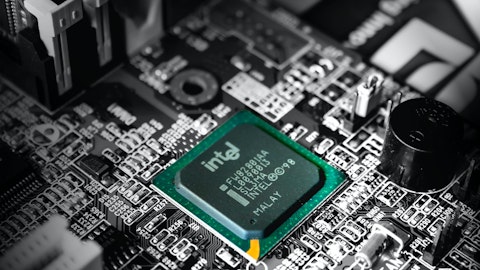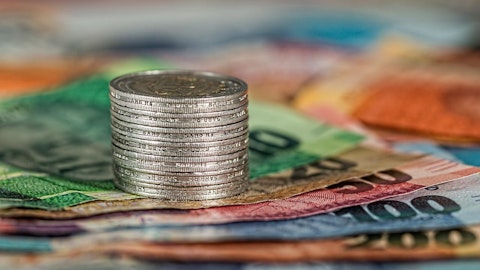Pat Gelsinger: Yes. Thank you. And I think the most important thing is what we just did with Sapphire Rapids, right? Our customers were anxious for a great product from Intel. Obviously, we would have liked it to be earlier, as we had initially estimated, but we are now shipping a very high-quality product with significant areas of leadership in areas like AI performance, power performance, security feature function, high-performance computing workflows that are 5x the competition and features in areas like confidential computing and security that are quite differentiated from anything in the marketplace. Obviously, share shift, right, particularly in the data center space, these designs were one a year ago, right, or two years ago.
And so it takes some amount of time. And against that, we’re seeing a very strong outlook for Sapphire Rapids ramp through the year, as I said, 1 million units in the middle of the year, so very strong demand from our customers. And the other thing, as we’ve indicated, is have we rewon our customers’ confidence that they could bet on our road map. And Emerald Rapids, looking very healthy for later this year. Granite Rapids and Sierra Forest looking very healthy for next year. And all of those, I believe, are rebuilding our customers’ confidence. And I believe with that, given the massive incumbency that Intel has, and I would just emphasize that even though we have seen the share shift in recent sell-in, the installed base is Intel, right? There’s an enormous on some — many of the cloud customers, 95-plus percent of their installed base is Intel that gives us a very strong incumbency that we get to renew as we rebuild our customers’ confidence.
So as you put all of those things together, yes, we realize that we stumble, right? We lost share. We lost momentum. We think that stabilizes this year, and we’re going to be building a road map that allows us to regain leadership for the long term in this critical market.
John Pitzer: Thanks, Vivek. Jonathan, can we have the next question, please.
Operator: Certainly. Our next question comes from the line of Timothy Arcuri from UBS. Your question, please.
Timothy Arcuri: Thanks a lot. Dave, I had a question on CapEx. I know you don’t want to guide for the full year, but you did say that 20% to 30% of the gross CapEx, whatever the number is this year, is going to be sets. I know you don’t have a lot of visibility on the chips money you’re going to get. But it seems like, best case, revenue is going to be in the mid-50s roughly. And if I take a little less than 35% of that, because you said that it’s still going to be 35% or less, that will be the net CapEx intensity. And I sort of divide the numbers, it implies a gross CapEx number, something in the range of $20 billion, give or take. Can you sort of help us just handicap that number?
David Zinsner: Yes. So let me see if I can — obviously, we’re trying to avoid guiding beyond the first quarter given the murkiness. I would just say we are very focused on the appropriate level of investment necessary for the long-term strategy of IDM 2.0, while being very thoughtful around how much CapEx we spend to manage our free cash flow. I think Smart Capital offsets will be pretty healthy this year, much better than last year. Partly, that’s because we’ll be fully along with SCIPs 1 with our partnership with Brookfield. We are expecting grant incentives to be a part of this year’s Smart Capital offsets. And so those — and then lastly, we do have already in place, the investment tax credit, which could have some benefit to us this year.
So certainly, Smart Capital will be healthy, but we are being very prudent around our gross capital spend through the year. And we’ll — as we kind of progress through the year, we’ll see how things develop, and we’ll — you can expect us to manage it accordingly. I think most importantly, we — we did not expect to be at this revenue level, obviously, for 2023 when we talked about this, net CapEx intensity of 35%. And yet we still maintain the discipline to stay at or below that 35% for the year. And I think that’s what investors should take away from that message.
Pat Gelsinger: Yes. Also, I’d just add, we do and Dave sort of implied it, but we do expect to do SCIP 2 this year as well, which is another source and also the credit center clearly there’s motivation on the part of commerce to get that underway and the rules making in place in the near future and start to dispense funds this year. Also, I’d point to Europe as well. So it’s EU chips as well as US chip. So all of those efforts are part of Smart Capital for us. We do believe that we’ll have the capital necessary to meet both our near-term but more importantly, the strategic long-term investments. And that’s what we say we’re on track with IDM 2.0. We’re on track with the capital, the builds that allow us to restore leadership in our process technology as well as have the factory capacity to both deliver that for our products as well as for our foundry customers.
John Pitzer: Tim, do you have follow-up?
Timothy Arcuri: I do, John. Dave, can you just sort of walk through maybe some of the gross margin puts and takes. I know that, again, you don’t want to guide for the full year. But — can you just help us think about what some of the puts and takes might be? I mean, obviously, as volumes grow, that will help gross margin. But are there any other puts and takes that you would sort of call out for us? Thanks.
David Zinsner: Yes. I think clearly, revenue is going to be the most significant driver of gross margins. We’re a high fixed cost model. So we suffer the consequence of that, obviously, when revenue is declining, but we also get the benefit when revenue is expanding. And so what will — what is currently a headwind does turn to a tailwind as the business recovers. The second most significant impact we have is the underload charges. So that’s 400 basis points or so this quarter. And we’ll make a determination as to what loading makes sense for the second quarter as we get closer to the second quarter. But we’re doing this to be appropriate in terms of our management of cash flow. But again, as business conditions adjust, we will start loading the fab at a higher rate, and that will improve gross margins.
I think beyond that, it really is around a lot of the cost initiatives we have underway. It’s the $3 billion for 2023, and it’s the $8 billion to $10 billion improvement over the course of the next few years that really will help drive the costs and drive the gross margins beyond just revenue and loadings.
John Pitzer: Thanks Tim. Jonathan, can we have the next question please?
Operator: Certainly. And our next question comes from the line of C.J. Muse from Evercore ISI. Your question please.
C.J. Muse: Thank you for taking the question. Another question on CapEx. I guess bigger picture, can you speak to your CapEx philosophy in a slower demand environment? Is it finding the right number to fit a free cash flow model, or are you looking at your overall demand picture and saying, we need X minus Y wafer starts, and that’s why we can spend less. Would love to get a sense of how the slowdown here is potentially changing or potentially not your strategy of spending? And if it’s not, is it just simply delaying investments into 2024 and 2025? Thanks.





